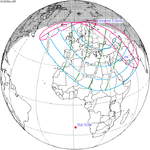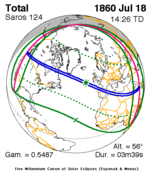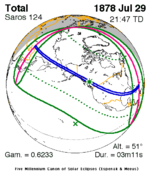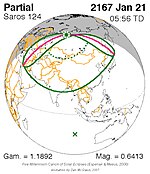Solar eclipse of November 26, 2076
| Solar eclipse of November 26, 2076 | |
|---|---|
| Type of eclipse | |
| Nature | Partial |
| Gamma | 1.1401 |
| Magnitude | 0.7315 |
| Maximum eclipse | |
| Coordinates | 63°42′N 40°06′E / 63.7°N 40.1°E |
| Times (UTC) | |
| Greatest eclipse | 11:43:01 |
| References | |
| Saros | 124 (58 of 73) |
| Catalog # (SE5000) | 9680 |
A partial solar eclipse will occur at the Moon's descending node of orbit on Thursday, November 26, 2076, with a magnitude of 0.7315. A solar eclipse occurs when the Moon passes between Earth and the Sun, thereby totally or partly obscuring the image of the Sun for a viewer on Earth. A partial solar eclipse occurs in the polar regions of the Earth when the center of the Moon's shadow misses the Earth.
This will be the last of four solar eclipses in 2076, with the others occurring on January 6, June 1, and July 1.
Related eclipses[edit]
Eclipses in 2076[edit]
- A total solar eclipse on January 6, 2076.
- A partial solar eclipse on June 1, 2076.
- A total lunar eclipse on June 17, 2076.
- A partial solar eclipse on July 1, 2076.
- A partial solar eclipse on November 26, 2076.
- A total lunar eclipse on December 10, 2076.
Metonic[edit]
- Preceded by: Solar eclipse of February 7, 2073
- Followed by: Solar eclipse of September 13, 2080
Tzolkinex[edit]
- Preceded by: Solar eclipse of October 15, 2069
- Followed by: Solar eclipse of January 7, 2084
Half-Saros[edit]
- Preceded by: Lunar eclipse of November 21, 2067
- Followed by: Lunar eclipse of December 1, 2085
Tritos[edit]
- Preceded by: Solar eclipse of December 27, 2065
- Followed by: Solar eclipse of October 26, 2087
Solar Saros 124[edit]
- Preceded by: Solar eclipse of November 16, 2058
- Followed by: Solar eclipse of December 7, 2094
Inex[edit]
- Preceded by: Solar eclipse of December 16, 2047
- Followed by: Solar eclipse of November 6, 2105
Triad[edit]
- Preceded by: Solar eclipse of January 26, 1990
- Followed by: Solar eclipse of September 28, 2163
Solar eclipses of 2076–2079[edit]
This eclipse is a member of a semester series. An eclipse in a semester series of solar eclipses repeats approximately every 177 days and 4 hours (a semester) at alternating nodes of the Moon's orbit.[1]
| Solar eclipse series sets from 2076 to 2079 | ||||
|---|---|---|---|---|
| Ascending node | Descending node | |||
| Saros | Map | Saros | Map | |
| 119 | June 1, 2076 Partial |
124 | November 26, 2076 Partial | |
| 129 | May 22, 2077 Total |
134 | November 15, 2077 Annular | |
| 139 | May 11, 2078 Total |
144 | November 4, 2078 Annular | |
| 149 | May 1, 2079 Total |
154 | October 24, 2079 Annular | |
Saros 124[edit]
This eclipse is a part of Saros series 124, repeating every 18 years, 11 days, and containing 73 events. The series started with a partial solar eclipse on March 6, 1049. It contains total eclipses from June 12, 1211 through September 22, 1968, and a hybrid eclipse on October 3, 1986. There are no annular eclipses in this set. The series ends at member 73 as a partial eclipse on May 11, 2347. Its eclipses are tabulated in three columns; every third eclipse in the same column is one exeligmos apart, so they all cast shadows over approximately the same parts of the Earth.
The longest duration of totality was produced by member 39 at 5 minutes, 46 seconds on May 3, 1734. All eclipses in this series occur at the Moon’s descending node of orbit.[2]
| Series members 43–64 occur between 1801 and 2200: | ||
|---|---|---|
| 43 | 44 | 45 |
 June 16, 1806 |
 June 26, 1824 |
 July 8, 1842 |
| 46 | 47 | 48 |
 July 18, 1860 |
 July 29, 1878 |
 August 9, 1896 |
| 49 | 50 | 51 |
 August 21, 1914 |
 August 31, 1932 |
 September 12, 1950 |
| 52 | 53 | 54 |
 September 22, 1968 |
 October 3, 1986 |
 October 14, 2004 |
| 55 | 56 | 57 |
 October 25, 2022 |
 November 4, 2040 |
 November 16, 2058 |
| 58 | 59 | 60 |
 November 26, 2076 |
 December 7, 2094 |
 December 19, 2112 |
| 61 | 62 | 63 |
 December 30, 2130 |
 January 9, 2149 |
 January 21, 2167 |
| 64 | ||
 January 31, 2185 | ||
References[edit]
- ^ van Gent, R.H. "Solar- and Lunar-Eclipse Predictions from Antiquity to the Present". A Catalogue of Eclipse Cycles. Utrecht University. Retrieved 6 October 2018.
- ^ "NASA - Catalog of Solar Eclipses of Saros 124". eclipse.gsfc.nasa.gov.
External links[edit]
- Earth visibility chart and eclipse statistics Eclipse Predictions by Fred Espenak, NASA/GSFC




